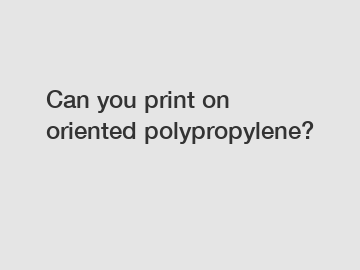Can you print on oriented polypropylene?
Can you print on oriented polypropylene (OPP)? The answer is yes, and in this article, we will explore the reasons behind this affirmative response, the process of printing on OPP, as well as the significance and impact of this capability.
OPP is a versatile and widely used material in the packaging industry due to its excellent clarity, moisture resistance, and high tensile strength. However, its surface properties pose a challenge for traditional printing methods. The nonporous nature of OPP makes it difficult for inks to adhere to its surface, resulting in poor print quality and durability.
To overcome these challenges, a specific printing process called flexographic printing is commonly employed for OPP. Flexography utilizes flexible relief plates made of rubber or photopolymer, which are wrapped around a printing cylinder. The inked plates transfer the image directly to the substrate, in this case, the OPP film.

The use of solvent-based inks is crucial for printing on OPP. These inks contain solvents that penetrate the smooth surface of the film, allowing for better adhesion and durability. The solvents in the ink interact with the polymer chains of the OPP film, creating a strong bond that resists smudging and rubbing.
Furthermore, surface treatment of OPP film can significantly enhance its printability. Corona treatment, a process that exposes the film to a high-frequency electric discharge, increases its surface energy. This treatment modifies the film's surface properties, making it more receptive to inks and improving print adhesion.
The ability to print on OPP opens up a world of possibilities for brand owners and manufacturers. They can now utilize OPP films for various packaging needs while incorporating eye-catching graphics, branding elements, and product information. This enhances the overall aesthetics and marketability of the packaged product.
In addition, printing on OPP brings about several practical benefits. The durability of solvent-based inks ensures that the printed information remains intact throughout the product's lifespan, resisting potential damages due to handling or environmental factors. This is particularly critical for applications such as food packaging, where legible and unaltered information is necessary for consumer safety and product compliance.
Moreover, the compatibility of OPP with flexographic printing allows for cost-effective mass production. The process is relatively fast, enabling high-speed printing on OPP films. Manufacturers can efficiently meet the demands of a competitive market while ensuring consistent print quality and productivity.
In conclusion, printing on oriented polypropylene (OPP) is indeed possible, thanks to flexographic printing and the use of solvent-based inks. The surface treatment of OPP films further enhances their printability, providing a wide range of opportunities for packaging design and visual communication. This capability not only improves the aesthetics and marketability of packaged products but also ensures the durability and legibility of printed information. With its cost-effectiveness and compatibility with mass production, printing on OPP offers an advantage to brand owners and manufacturers in meeting consumer demands.
If you are looking for more details, kindly visit polyester films, what is bopp plastic, difference between pp bags and bopp bags.

Comments
0